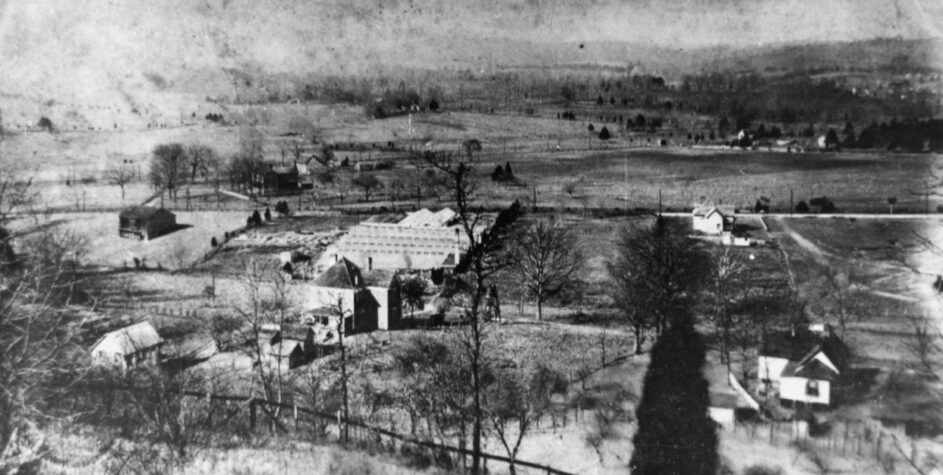In 1846, the widowed Katherine Schneider Baum and her 15-year-old son Karl (1831-1916) left their native country during the German Revolution and immigrated to America on the sailing ship New York. The voyage of 47 days was extremely stormy and, on a particularly tempestuous day, young Karl was tied to the mast of the ship with an axe in his hands. His instructions were to cut down the tall mast if the ship should yaw and threaten to capsize in the heavy seas.
Finally, they landed safely in New York. Karl could not find work there, and they set sail for Charleston, S.C. After some months there they traveled to Augusta, Georgia, where he was hired to lay railroad track from there to Charleston in Bradley County, Tennessee. Eventually, he was employed by the East Tennessee and Georgia Railroad to assist in construction of the first railroad bridge over the Hiawassee River between Charleston and Calhoun.
On July 24, 1855, upon completion of the bridge, he and his mother came to Knoxville on the first train to run over the ET&G. For the next 56 years, Karl would be in the employ of that railroad and its successor, the Southern Railway.

The Baum Brothers. Karl P. Baum (1885-1977) (foreground) and his brother Floyd F. Baum (1898-1985) were pictured in 1952 when their sales at Baum’s Home of Flowers were over $500,000 per year. (Photos by C.M. McClung Historical Collection)
Karl Baum married Barbara Ritz on Aug. 7, 1860, and they became parents of 10 children, among them Charles Louis Baum (1863-1944). Charles married Mattie Ellen Galyon in 1884. He was employed in the iron industry as superintendent of a foundry but left that secure job to enter the florist business in 1889. His first venture was an open pit greenhouse on Tazewell Pike from which he sold a few plants and cut flowers in the old Central Market (now Emory Park). By 1892 he had opened a retail store in downtown Knoxville.
As the business grew, each of his children entered the business which prospered to become the largest greenhouse operation, the largest rose grower and the second largest retail florist in the Southeast.
In mid-life, Charles turned the business over to his children, moved to Gatlinburg and helped develop the Cherokee Apple Orchard. When the National Park Service bought the property, he became an unofficial botanist to assist in identifying Smoky Mountain flora.
Karl Porter Baum (1885-1977) was the oldest of the four children of Charles and Mattie Galyon Baum and Floyd Franklyn Baum (1898-1985) the youngest.
Karl entered school at Smithwood Grammar School but quit when he was 13 to work full time with his father. When he was 17, he took over sales at Baum’s small store on W. Clinch Avenue.
The business continued to grow. Baum’s introduced gladioli to the South and had 25 acres of them at one time. His father had helped propagate the beautiful Lilium Myriophyllum (Regale), the Royal Lily of China, which was first imported from Tibet in 1910. Wild orchids from South America were imported and grown in the greenhouses. Roses were, of course, a major year-round item. At one time the firm had 180 agents taking orders for its wares, and eventually Baum’s had more greenhouses, including those in Smithwood and Bearden, than anyone in the U.S. They occupied 2 ½ acres with more than 340,000 feet of glass and an additional 70 acres in bulbs and other outdoor plants.
Karl Baum was one of those responsible when Florists’ Telegraph Delivery (FTD) was organized in 1910. The then-novel idea enabled one to send flowers to any American or Canadian city and to some other parts of the world and grew to include a staggering 1,700 members by the end of the decade. Karl was vice-president of the FTD association at one time.
Floyd F. Baum developed the Bearden greenhouse operation beginning in 1926. By 1972, there were 34 greenhouses when they were dismantled to make way for Bearden Industrial Park. Floyd’s specialty was roses and his greenhouses once held 133,000 rose plants which produced four million blooms a year. One of his popular hybrids, named the Betty Baum rose for his daughter, is a beautiful white rose edged in pink. He also produced carnations, chrysanthemum and other fresh flowers and plants supplied to Baum’s local retail outlets and wholesale florists all over the South.
A July 1952 issue of Fortune magazine included Baum’s among other successful businesses and described them, “A Knoxville iron molder who grew lilies and roses as a hobby started Baum’s Home of Flowers in 1889. His sons now operate the most modern greenhouses in the South and sell over $500,000 worth of flowers a year. Karl Baum, president, believes in posting prices clearly in the window of his retail store to reassure hesitant buyers.”
Karl P. Baum died in 1974 and Floyd Baum assumed the presidency until the retail shops at 631 S. Gay St. and 2916 Tazewell Pike and the greenhouses on Tazewell Pike were sold to Mark E. Ross of New York in March 1975.
When the patriarch of the Baum’s Home of Flowers’ family, Charles L. Baum, passed away in 1944, it was said of him, “Not only did he achieve a little success and a lot of satisfaction from his chosen vocation but his exemplary life and devotion to duty was such that all his children were influenced to follow his example and remain in the business that he established. It can truly be said that he plucked a thistle and planted a flower wherever he thought a flower would grow. He stood firm in his convictions and was loyal to his friends almost to a fault. He never forgot those who befriended him or gave him a kind word on his way up.” Subsequent generations of Baums followed his example of a principled life.
Jim Tumblin, retired optometrist and active historian, writes a monthly series on Fountain City for KnoxTNToday.com.

